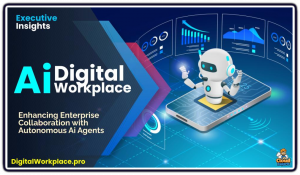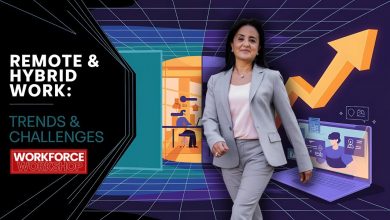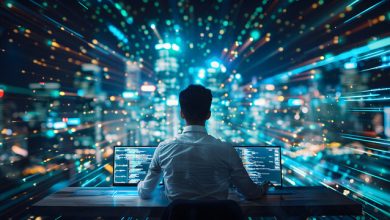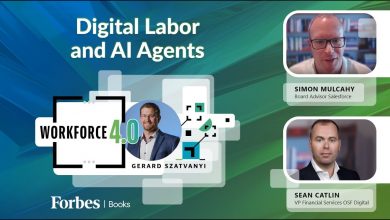Human-AI Collaboration: The Key To Workplace Efficiency And Innovation
Far from replacing humans, AI is emerging as a powerful collaborator, amplifying our strengths, streamlining our processes, and pushing the boundaries of what’s possible.
 In today’s fast-evolving world, the workplace is no longer defined solely by human ingenuity or manual effort.
In today’s fast-evolving world, the workplace is no longer defined solely by human ingenuity or manual effort.
A new era has dawned—one where artificial intelligence (AI) and human creativity intertwine to unlock unprecedented levels of efficiency and innovation.
Far from replacing humans, AI is emerging as a powerful collaborator, amplifying our strengths, streamlining our processes, and pushing the boundaries of what’s possible. The future of work lies in this partnership, where humans and AI each bring unique capabilities to the table, creating a synergy that drives progress like never before.
The Complementary Strengths of Humans and AI
At the heart of human-AI collaboration is the recognition that both parties excel in distinct areas. Humans possess emotional intelligence, intuition, and the ability to navigate complex ethical dilemmas—qualities that remain beyond the reach of even the most advanced algorithms.
We dream, empathize, and inspire, crafting visions that resonate on a deeply personal level. AI, on the other hand, thrives in the realm of data, speed, and precision. It can process vast amounts of information in seconds, identify patterns invisible to the human eye, and perform repetitive tasks with flawless consistency.
Imagine a marketing team tasked with launching a new campaign. The human marketers brainstorm the big idea, drawing on cultural insights and emotional resonance to craft a compelling narrative. Meanwhile, AI analyzes consumer data, predicts trends, and optimizes the campaign’s reach across platforms—all in real time. Together, they achieve what neither could alone: a strategy that’s both creatively bold and data-driven, delivered faster and more effectively than ever.
This complementary dynamic is not limited to creative fields. In manufacturing, AI-powered robots handle precision assembly while human workers oversee quality control and troubleshoot unexpected challenges. In healthcare, AI sifts through medical records to suggest diagnoses, freeing doctors to focus on patient care and nuanced decision-making. Across industries, the message is clear: when humans and AI collaborate, they don’t just work harder—they work smarter.
Boosting Efficiency Through Seamless Integration
One of the most immediate benefits of human-AI collaboration is its ability to supercharge workplace efficiency. Repetitive, time-consuming tasks that once bogged down teams—data entry, scheduling, inventory tracking—can now be delegated to AI systems, allowing employees to focus on higher-value work. This shift doesn’t just save time; it redefines roles, empowering workers to engage in strategic thinking, problem-solving, and innovation.
Consider the example of customer service. AI chatbots can handle routine inquiries—password resets, order statuses—around the clock, reducing wait times and operational costs. When a query escalates beyond the bot’s capabilities, it seamlessly hands off to a human agent who brings empathy and judgment to resolve the issue.
The result? Faster resolutions, happier customers, and a workforce that’s free to tackle more complex challenges.
Efficiency gains also extend to decision-making. AI’s ability to analyze real-time data equips leaders with actionable insights at a moment’s notice. Whether it’s predicting market shifts, optimizing supply chains, or identifying bottlenecks, AI provides the clarity humans need to act decisively. Yet, it’s the human touch—the ability to weigh risks, consider ethical implications, and inspire teams—that turns those insights into meaningful outcomes.
Igniting Innovation at the Intersection of Minds and Machines
While efficiency is a powerful outcome of human-AI collaboration, its true potential lies in sparking innovation. When AI handles the grunt work, humans gain the mental bandwidth to dream bigger, experiment boldly, and push into uncharted territory. At the same time, AI’s analytical prowess can uncover opportunities that might otherwise go unnoticed, serving as a springboard for human creativity.
Take the field of scientific research. AI can sift through decades of studies, cross-referencing data to suggest hypotheses or identify promising drug compounds. Scientists, in turn, design experiments, interpret results, and contextualize findings within the broader scope of human health. This partnership has already accelerated breakthroughs—from faster vaccine development to personalized medicine—demonstrating how collaboration can solve problems once thought intractable.
In the corporate world, innovation thrives when AI augments human ingenuity. Designers use generative AI to iterate on prototypes rapidly, while engineers leverage simulations to test ideas without costly physical trials. Leaders, meanwhile, harness AI-driven scenario planning to anticipate disruptions and chart new paths forward.
The result is a workplace where experimentation is democratized, risks are minimized, and bold ideas flourish.
Overcoming Challenges to Build a Collaborative Future
Of course, human-AI collaboration isn’t without its hurdles. Successful integration requires trust, adaptability, and a willingness to upskill. Workers must feel confident that AI is a partner, not a threat—a perception that hinges on transparent communication from leadership.
Organizations must also invest in training, ensuring employees can leverage AI tools effectively while honing the uniquely human skills—like critical thinking and collaboration—that remain irreplaceable.
Ethical considerations loom large as well. As AI takes on more responsibility, questions of bias, accountability, and privacy demand human oversight. Here, too, collaboration is key: humans must guide AI’s development, setting guardrails that align with societal values and organizational goals.
The Road Ahead: A Partnership for Progress
The workplaces of tomorrow will not be defined by AI alone, nor by humans in isolation. They will be shaped by a dynamic partnership—one where machines amplify our capabilities and humans imbue technology with purpose. This collaboration promises not just greater efficiency and innovation, but a reimagining of work itself, where mundane tasks fade away and meaningful contributions take center stage.
As we stand at this crossroads, the choice is ours: embrace AI as a co-creator, or risk falling behind in a world that rewards adaptability. The evidence is mounting—companies that prioritize human-AI collaboration are already outpacing their peers, delivering results that blend the best of both worlds. The future is not a zero-sum game; it’s a canvas for cooperation, where humans and AI, together, paint a picture of progress that’s as inspiring as it is inevitable.
Let’s seize this moment. The key to unlocking workplace efficiency and innovation isn’t in choosing between humans and AI—it’s in choosing both.



